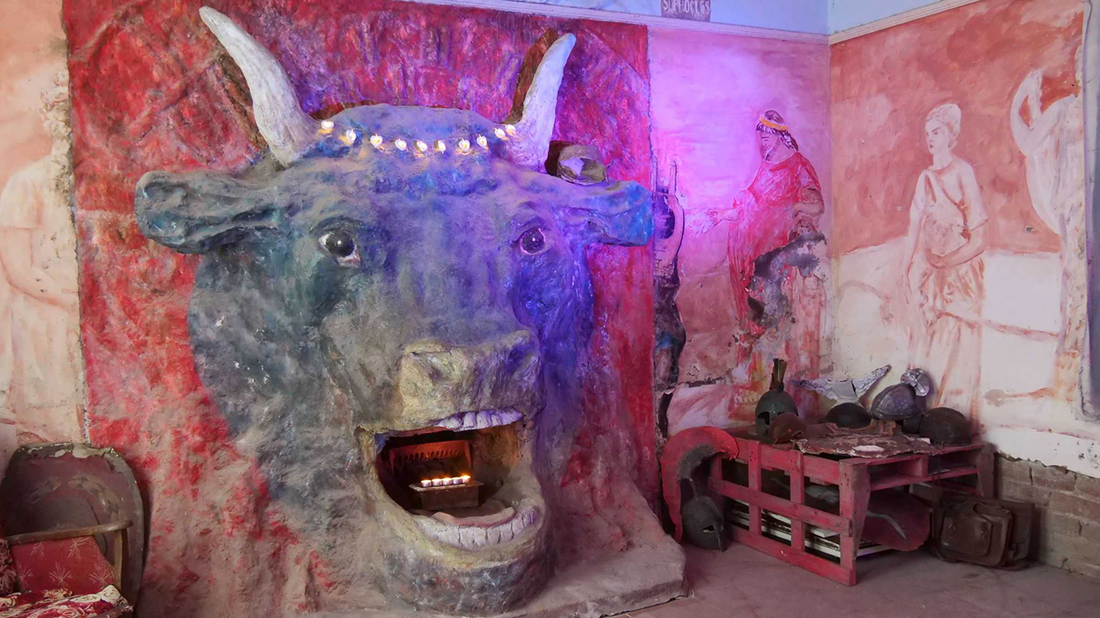Ever stumbled upon a piece of art that feels like a secret whispered in a crowded room? That's the essence of outsider art—an intriguing realm where creativity knows no bounds and conventionality takes a backseat. But what exactly is outsider art, and where does it thrive? Join us on a journey to unravel the mysteries of this captivating genre.
Outsider art, also known as art brut or insider art, defies the norms of traditional artistic expression. It emerges from the minds of individuals operating beyond the confines of mainstream culture, offering a raw and unfiltered glimpse into their inner worlds. While outsider art transcends borders, certain countries have become hotspots for its flourishing. From the hauntingly beautiful works of Henry Darger in the United States to the intricate sculptures of Adolf Wölfli in Switzerland, here are five examples of outsider artists whose creations have left an indelible mark on the genre.
Ron's Place, Birkenhead UK. Ron took on the tenancy of his ground floor flat in 1986. The tenancy agreement allowed him to ‘decorate the interior of the property to his own taste and the external porch in classical style without the prior written consent of the Landlord’. He also had full use of the garden which he was at liberty to landscape at his own expense. The premises were in a constant state of transformation over time according to Ron’s own documentation and the few visitors who crossed the threshold.

Henry Darger (United States): Henry Darger was the ultimate recluse-turned-artist. Living a solitary life in Chicago, he left behind an astonishing legacy of artwork and writings after his death. His epic fantasy world, depicted in vivid detail through paintings and a 15,000-page manuscript, captivates audiences with its imaginative scope and haunting beauty.
A documentary directed by Jessica Yu, it tells the story of a friendless Chicago janitor called Henry Darger, who spent most of his life building acollection of string balls and medicine bottles, to go with his compulsive drawings of naked girls with tiny penises being strangled, blown up, beheaded and disembowelled. This Guardian article includes a great description of Darger and his creepy but artistically mindblowing world.
Later on in his life, Darger moved into a room in the Lincoln Park area of Chicago in 1930. He found a job as a janitor in a Catholic hospital with the help of his godmother and worked until his retirement in 1963. He attended mass daily, often multiple times. Darger became ill and was taken to St. Augustine’s, where he died in 1973. His landlord, Nathan Lerner, realized the power of his work while dismantling the stacks and piles that filled his room. Much of Darger’s writing and collection is now at Intuit: The Center for Intuitive and Outsider Art in Chicago. The Henry Darger Study Collection at the American Folk Art Museum in New York also holds many of his works.

Adolf Wölfli (Switzerland): Adolf Wölfli, a Swiss artist, spent much of his life in psychiatric institutions. Despite his challenging circumstances, Wölfli produced an extraordinary body of work characterized by intricate drawings and collages. His art serves as a window into his inner world, blending mythological motifs with personal symbolism in mesmerizing ways.

Howard Finster (United States): Howard Finster, often dubbed the "backwoods preacher-artist," gained fame for his visionary artwork. Based in Georgia, Finster's eclectic creations ranged from vibrant paintings to whimsical sculptures, all infused with his unique blend of spirituality and folk art aesthetics. His Paradise Garden, a sprawling outdoor installation, remains a testament to his creative vision.

Scottie Wilson (United Kingdom): Born in Scotland, Scottie Wilson discovered his passion for art later in life. Known for his distinctive "spatter" style, Wilson's intricate designs often featured fantastical creatures and elaborate patterns. His work gained recognition in the art world, leading to exhibitions and acclaim for his unorthodox approach to expression.
In the early 1950s, he travelled to France at the persuasion of artist and outsider art fanatic Jean Dubuffet. There Wilson was met by not only Dubuffet, but also by Pablo Picasso; both were fans and owners of Wilson's work. According to art critic Bill Hopkins, a friend of Wilson who accompanied him on the trip:

Ron's Place (United Kingdom): Tucked away in Birkenhead, UK, Ron's Place is a hidden gem in the outsider art scene. Ron Gittins, the visionary behind this extraordinary space, transformed his home into a kaleidoscope of color and creativity. Every inch of Ron's Place is adorned with his intricate artwork, ranging from painted walls to whimsical sculptures, offering a glimpse into the mind of a true outsider artist.


Judith Scott (USA) born deaf and with Down syndrome in 1943, faced institutionalization until her sister Joyce gained custody in 1986. Introduced to art at Creative Growth Art Center, Scott's textile sculptures became her medium of expression. Using found objects wrapped in yarn, her pieces embody intricate layers and textures, often resembling cocoons or totems. Scott's work defies conventional categorization, blurring lines between sculpture and textile art. Despite starting her artistic journey late in life, her pieces gained international acclaim, exhibited in prestigious galleries worldwide. Scott's success transcended her lifetime, with her artworks recognized for their profound emotional depth and unique aesthetic.


Summary
These days we see galleries dedicated solely to this type of work; but it is generally work made by artists who are no longer living. Can we move away from the idea that successful art is exclusive and unobtainable? Only when we are able to do this will the art world truly be equitable and more diverse.
Why am i interested in Outsider art?
I am a bag designer but have always loved to create art. I have always struggled with the idea of whether one can be an artist if they are not classically trained or work within that area in my 'day job'. On the side of designing cycling bags for Goodordering. Here below is one of my recent paintings of the Mona Lisa.






